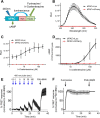Luminescence-activated nucleotide cyclase regulates spatial and temporal cAMP synthesis
- PMID: 30559293
- PMCID: PMC6349105
- DOI: 10.1074/jbc.AC118.004905
Luminescence-activated nucleotide cyclase regulates spatial and temporal cAMP synthesis
Abstract
cAMP is a ubiquitous second messenger that regulates cellular proliferation, differentiation, attachment, migration, and several other processes. It has become increasingly evident that tight regulation of cAMP accumulation and localization confers divergent yet specific signaling to downstream pathways. Currently, few tools are available that have sufficient spatial and temporal resolution to study location-biased cAMP signaling. Here, we introduce a new fusion protein consisting of a light-activated adenylyl cyclase (bPAC) and luciferase (nLuc). This construct allows dual activation of cAMP production through temporally precise photostimulation or chronic chemical stimulation that can be fine-tuned to mimic physiological levels and duration of cAMP synthesis to trigger downstream events. By targeting this construct to different compartments, we show that cAMP produced in the cytosol and nucleus stimulates proliferation in thyroid cells. The bPAC-nLuc fusion construct adds a new reagent to the available toolkit to study cAMP-regulated processes in living cells.
Keywords: bPAC; bioluminescence; cell proliferation; compartmentalization; cyclic AMP (cAMP); fluorescence resonance energy transfer (FRET); microdomains; nano-luciferase; optogenetics; second messenger; signaling; thyroid.
© 2019 Naim et al.
Conflict of interest statement
The authors declare that they have no conflicts of interest with the contents of this article
Figures



Similar articles
-
Dual Activation of cAMP Production Through Photostimulation or Chemical Stimulation.Methods Mol Biol. 2020;2173:201-216. doi: 10.1007/978-1-0716-0755-8_14. Methods Mol Biol. 2020. PMID: 32651920 Free PMC article.
-
Cyclic nucleotide-gated channels colocalize with adenylyl cyclase in regions of restricted cAMP diffusion.J Gen Physiol. 2000 Aug;116(2):147-61. doi: 10.1085/jgp.116.2.147. J Gen Physiol. 2000. PMID: 10919863 Free PMC article.
-
PACmn for improved optogenetic control of intracellular cAMP.BMC Biol. 2021 Oct 18;19(1):227. doi: 10.1186/s12915-021-01151-9. BMC Biol. 2021. PMID: 34663304 Free PMC article.
-
Elucidating cyclic AMP signaling in subcellular domains with optogenetic tools and fluorescent biosensors.Biochem Soc Trans. 2019 Dec 20;47(6):1733-1747. doi: 10.1042/BST20190246. Biochem Soc Trans. 2019. PMID: 31724693 Review.
-
Pharmacological modulation of the CO2/HCO3-/pH-, calcium-, and ATP-sensing soluble adenylyl cyclase.Pharmacol Ther. 2018 Oct;190:173-186. doi: 10.1016/j.pharmthera.2018.05.008. Epub 2018 May 26. Pharmacol Ther. 2018. PMID: 29807057 Free PMC article. Review.
Cited by
-
CAP1 binds and activates adenylyl cyclase in mammalian cells.Proc Natl Acad Sci U S A. 2021 Jun 15;118(24):e2024576118. doi: 10.1073/pnas.2024576118. Proc Natl Acad Sci U S A. 2021. PMID: 34099549 Free PMC article.
-
Engineered BRET-Based Biologic Light Sources Enable Spatiotemporal Control over Diverse Optogenetic Systems.ACS Synth Biol. 2020 Jan 17;9(1):1-9. doi: 10.1021/acssynbio.9b00277. Epub 2019 Dec 17. ACS Synth Biol. 2020. PMID: 31834783 Free PMC article.
-
Whole-Cell cAMP and PKA Activity are Epiphenomena, Nanodomain Signaling Matters.Physiology (Bethesda). 2019 Jul 1;34(4):240-249. doi: 10.1152/physiol.00002.2019. Physiology (Bethesda). 2019. PMID: 31165682 Free PMC article. Review.
-
Neurophotonic tools for microscopic measurements and manipulation: status report.Neurophotonics. 2022 Jan;9(Suppl 1):013001. doi: 10.1117/1.NPh.9.S1.013001. Epub 2022 Apr 27. Neurophotonics. 2022. PMID: 35493335 Free PMC article.
-
Dual Activation of cAMP Production Through Photostimulation or Chemical Stimulation.Methods Mol Biol. 2020;2173:201-216. doi: 10.1007/978-1-0716-0755-8_14. Methods Mol Biol. 2020. PMID: 32651920 Free PMC article.
References
-
- Sutherland E. W., and Rall T. W. (1958) Fractionation and characterization of a cyclic adenine ribonucleotide formed by tissue particles. J. Biol. Chem. 232, 1077–1091 - PubMed
Publication types
MeSH terms
Substances
Grants and funding
LinkOut - more resources
Full Text Sources
Research Materials

